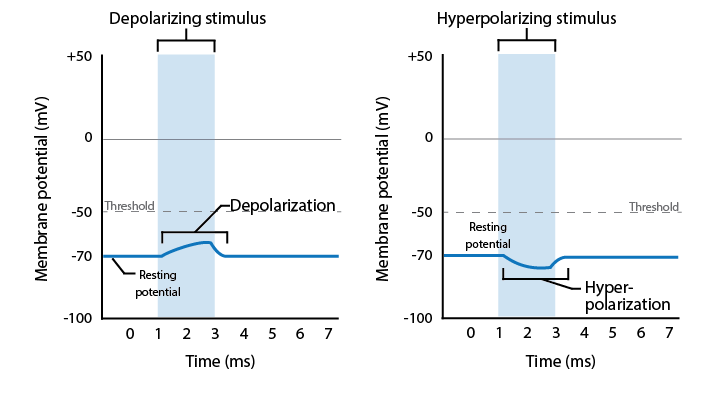CELL MEMBRANES-ELECTROPHYSIOLOGY
Graded Potentials
First, some new terminology. Because we are dealing with charge differences and electrical currents, we use some unique terms to describe certain states of the membrane. At rest, the membrane is in a polarized state; polarized because of charge separation caused by the different ions. This polarized state is often referred to as the resting membrane potential. As already emphasized, the inside of the cell membrane will be negative in relation to the outside of the membrane. We can show this graphically by using the units of mV on the y axis, and time on the X axis (see figure below). Thus, any change in the membrane toward zero will be termed a depolarization. Note the prefix de, which means away from. Any change in the membrane that moves back toward the resting potential would be a repolarization with the prefix re, meaning again. A change resulting in movement away from the resting potential, but in a more negative direction, away from zero, will be termed hyperpolarization with the prefix hyper, meaning excessive.

Image created at BYU-Idaho, 2013.
Graphical representation of "Graded Potentials". On the left it shows electrical movement away from rest or "polarized state, toward zero called "depolarization". The graded potential returns to rest "or polarized state again, but never gets high enough to reach threshold. The representation on the right shows electrical movement away from rest. This movement is called hyperpolarization and we see that hyperpolarization moves farther from threshold rather than towards it.
Now for some application. Opening channels for Na+ or Ca++ would cause a depolarization, while opening channels for K+ or Cl- would cause a repolarization, or even a hyperpolarization. These changes in the resting potential come in two forms; as graded potentials or action potentials. Graded potentials always precede action potentials, so we'll address them first.
With graded potentials, the magnitude of the response is proportional to the strength of the stimulus. Hence, a strong stimulus might result in a 10mV change in the membrane potentials, while a weaker stimulus may produce only a 5mV change. Graded potentials result from the opening of mechanical, or ligand-gated channels. Graded potentials can be summed, or added on top of each other to increase the change. Stated another way, if a stimulus is repeated over and over it can result in an even larger deviation toward zero, from rest or away from rest to more negative values. This is the reason why the changes are called graded. The amplitude (change in the membrane potential) is determined by the number of channels activated, which in turn is determined by the amount of stimulus, for example, the concentration of chemicals, or the number of channels. However, if a change in the depolarizing direction is really strong, the change may exceed the threshold for the cell and the graded potential changes into an action potential. Another characteristic of graded potentials is that they are conducted only short distances. As the signal spreads from the site of stimulation, it loses strength and eventually dies out completely; think of the ripples that spread in a pond when you throw a rock in. For this reason, these signals are also sometimes referred to as local potentials, meaning that they happen locally, but do not travel long distances. Although not as glamorous as their big brother, the action potential, they are the triggers that initiate action potentials; so without them, action potentials would not happen.
**You may use the buttons below to go to the next or previous reading in this Module**


